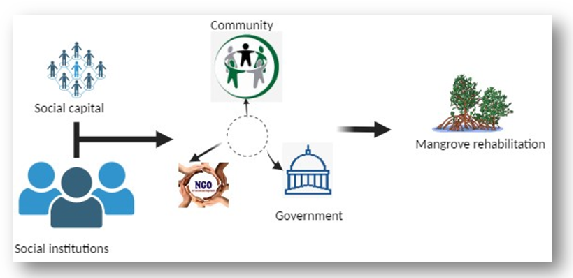Document Type : CASE STUDY
Authors
1 Agribusiness Department, Faculty of Agriculture, University of Lampung, Indonesia
2 Research Center for Oceanography, National Research and Innovation Agency, Jakarta, Indonesia
Abstract
BACKGROUND AND OBJECTIVES: Improving welfare requires continuous and various efforts, including enhancing social capital and local institutions for the preservation of mangrove forests. Reinforcing local social and institutional capital to enhance mangrove ecosystems is crucial for understanding the intricate social systems necessary to conserve, manage, and restore mangrove ecosystem services. The purpose of this study is to determine the relationship between social capital and social institutions with the sustainability of mangrove rehabilitation in the Teluk Pandan and Padang Cermin districts of Lampung, Indonesia, in 2023.
METHODS: This study analyzes the role of local social and institutional capital in the welfare of communities residing around mangrove forests in the Way Ratai district of Pesawaran Regency. This study employs a survey research approach, drawing samples from the population, and utilizes both quantitative and qualitative data analysis. A sample of 300 respondents was selected based on the guidelines for Structural Equation Model analysis. The study was carried out in two sub-districts of Pesawaran Regency. The districts were deliberately chosen due to the fact that they are designated mangrove forest rehabilitation areas. Data collection took place from July to December 2023. Data analysis involved tabulation techniques and Structural Equation Model analysis using Linear Structural Relations.
FINDINGS: The findings suggest that social institutions, such as customary practices, sanctions, and conflict, have a negative impact on mangrove rehabilitation and welfare. Increasing the social capital of communities surrounding mangrove forests has a significant influence on mangrove rehabilitation and welfare, including the fulfillment of basic needs like shelter, food, access to healthcare, and education. Community leaders oversee activities, encourage community involvement in mangrove rehabilitation, and ensure the smooth running of government programs.
CONCLUSION: Social capital can be enhanced through group meetings, social gatherings, initiatives to raise awareness about tourism, and mangrove conservation groups. The goal of empowerment is to create self-sufficient and socially empowered communities capable of meeting their physical, economic, and social needs. This fosters self-confidence and allows them to voice their aspirations, secure their livelihoods, engage in social endeavors, and face life independently. Social capital influences community participation in mangrove rehabilitation.
Graphical Abstract
Highlights
- The best model for enhancing community well-being around mangrove forests is to strengthen social capital, social institutions, stakeholder roles, and mangrove rehabilitation;
- Padang Cermin and Teluk Pandan have a strong social capital, with a sense of togetherness and a high awareness of the importance of mangrove conservation;
- The goal of empowerment is to create self-sufficient and socially sustainable communities capable of meeting their physical, economic, and social needs, fostering self-confidence;
- Stakeholders include the government, community groups, and community leaders.
Keywords
Main Subjects
OPEN ACCESS
©2024 The author(s). This article is licensed under a Creative Commons Attribution 4.0 International License, which permits use, sharing, adaptation, distribution and reproduction in any medium or format, as long as you give appropriate credit to the original author(s) and the source, provide a link to the Creative Commons license, and indicate if changes were made. The images or other third party material in this article are included in the article’s Creative Commons license, unless indicated otherwise in a credit line to the material. If material is not included in the article’s Creative Commons license and your intended use is not permitted by statutory regulation or exceeds the permitted use, you will need to obtain permission directly from the copyright holder. To view a copy of this license, visit:
http://creativecommons.org/licenses/by/4.0/
PUBLISHER NOTE
GJESM Publisher remains neutral concerning jurisdictional claims in published maps and institutional affiliations.
CITATION METRICS & CAPTURES
Google Scholar | Scopus | Web of Science | PlumX Metrics | Altmetrics | Mendeley |
CURRENT PUBLISHER



Letters to Editor
[1] Letters that include statements of statistics, facts, research, or theories should include appropriate references, although more than three are discouraged.
[2] Letters that are personal attacks on an author rather than thoughtful criticism of the author’s ideas will not be considered for publication.
[3] Letters can be no more than 300 words in length.
[4] Letter writers should include a statement at the beginning of the letter stating that it is being submitted either for publication or not.
[5] Anonymous letters will not be considered.
[6] Letter writers must include their city and state of residence or work.
[7] Letters will be edited for clarity and length.
Send comment about this article